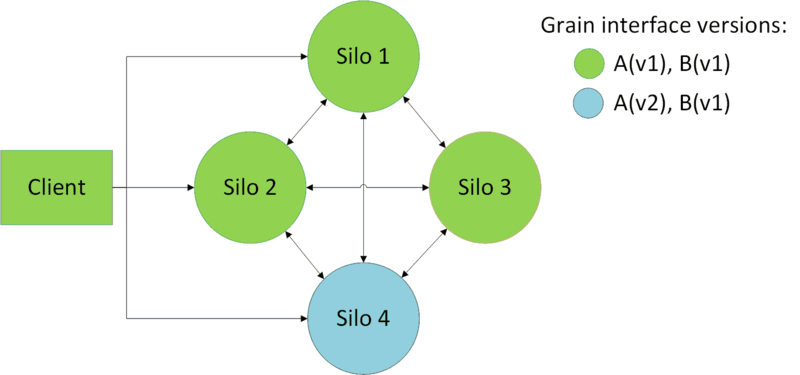Grain interface versioning
In this article, you'll learn how to use grain interface versioning. The versioning of Grain state is out of scope.
Overview
On a given cluster, silos can support different versions of a grain type.

In this example, the client and Silo{1,2,3} were compiled with grain interface A version 1. Silo 4 was compiled with A version 2.
Limitations
- No versioning on stateless worker
- Streaming interfaces are not versioned
Enable versioning
If the version attribute is not explicitly added to the grain interface, then the grains have a default version of 0. You can version grain by using the VersionAttribute on the grain interface:
[Version(X)]
public interface IVersionUpgradeTestGrain : IGrainWithIntegerKey
{
}
Where X is the version number of the grain interface, which is typically monotonically increasing.
Grain version compatibility and placement
When a call from a versioned grain arrives in a cluster:
- If no activation exists, a compatible activation will be created
- If an activation exists:
- If the current one is not compatible, it will be deactivated and new compatible one will be created (see version selector strategy)
- If the current one is compatible (see compatible grains), the call will be handled normally.
By default:
- All versioned grains are supposed to be backward-compatible only (see backward compatibility guidelines and compatible grains). That means that a v1 grain can make calls to a v2 grain, but a v2 grain cannot call a v1.
- When multiple versions exist in the cluster, the new activation will be randomly placed on a compatible silo.
You can change this default behavior via the GrainVersioningOptions:
var silo = new HostBuilder()
.UseOrleans(c =>
{
c.Configure<GrainVersioningOptions>(options =>
{
options.DefaultCompatibilityStrategy = nameof(BackwardCompatible);
options.DefaultVersionSelectorStrategy = nameof(MinimumVersion);
});
});
Feedback
Coming soon: Throughout 2024 we will be phasing out GitHub Issues as the feedback mechanism for content and replacing it with a new feedback system. For more information see: https://aka.ms/ContentUserFeedback.
Submit and view feedback for
